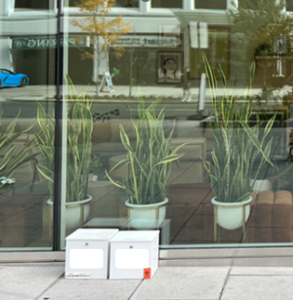In follow-up to my February 25, 2025 post, New CAP Survey Coag POC Requirements, I asked Dr. Andrew Goodwin, “Does CAP address courier specimen management? I see specimens collected at regional clinics that stand in a door-mounted specimen box for extended periods. I also wonder whether couriers have equipment maintaining coag specimen temperatures between 18 and 25°C in winter and summer temperatures.”
Dr. Goodwin began, “Below is a photo I took last summer. While out for a hot Saturday stroll, I found these lab specimens sitting on the sidewalk outside a clinic in the direct noon-time sunlight!”
While ensuring appropriate temperature for specimen integrity is vital, mobile temperature monitoring and cooler technology does not make this easy and efficient. Ideally, the cooler would automatically monitor internal temperature and indicate when min/max temperature(s) are exceeded.
CAP has accreditation standards, listed below. There is no absolute requirement for temperature monitoring at the level you describe. At my institution, our receiving department will confirm that frozen specimens are indeed frozen, the refrigerated specimens feel cool to the touch, and the room temperature specimens are “not too hot and not too cold.” The coolers are packed with ice packs or dry ice for frozen, cooling packs for refrigerated, or nothing for room temperature.
The 2025 CAP standards include GEN.40125: Handling of Referred Specimens, GEN.40515: Transport Personnel Training, and GEN.40530: Specimen Tracking.
- GEN.40125 provides guidelines for the referring laboratory addressing, for instance, tube selection, storage temperature, time, and separation protocol.
- GEN.40515 recommends training transport personnel on the packaging, safe handling, temperature, and documentation.
- GEN.40530 prescribes a tracking system that records temperature, time of specimen pickup and delivery and specimen identity for laboratory-contracted couriers.
I’ve polled a few hemostasis specimen management experts for their experiences. Watch for notes in the Comments section below, or add your own stories.
3-1-25 comment from colleague Bob Gosselin: Excellent points that would be challenging to assess, although spot checking using transport temp indicators (often used by IVD shipping temp sensitive reagents thru weather extremes) seems prudent. Toss in pneumatic tube systems, although one company, Motryx, has a cool monitoring toy to measure temp and vibration through pneumatic tube transport.
Additional (3-3-25) comments from Bob Gosselin:
Yikes moments! It seems there may be more issues than just a temperature-controlled environment:
- Are these drop boxes mounted/secured onto the pavement?
- It is unclear whether the inside is insulated like a cooler—that would certainly be more comforting than what I can only speculate about this drop box.
- Kinda cheesy “lock.”
- Only one box has biohazardous labelling; what’s the other for it?
- I’m curious about compliance with HIPAA with this kinda setup, as these boxes appear to be fairly easy access as samples likely have labelling, paperwork, etc.
- It’s likely most doctor offices, student health centers, and urgent care clinics have defined hours of operations. Many have external (to the building) drop boxes, but in my experience they are more secure than what is shown.



I really did not check their boxes for temperature. I left that responsibility to the courier service and the receiving lab. I just made sure that I documented and followed the receiving lab’s requirements. I also felt that if I looked at the courier’s equipment, then I would also need to inspect their maintenance records and document it in my lab for possible inspection purposes.
In addition to the sample boxes seen in the images above, I have seen styrofoam boxes with frozen plasma/serum aliquoted and stored on dry ice that don’t even fit in these “sample” boxes. When my laboratory sent samples out for analysis, couriers came into the lab to retrieve the samples and transferred the samples to their “regulated” storage containers (frozen vs ice pack vs room temp) where they recorded and maintained storage conditions for the receiving lab. Once the sample left the lab, the courier service was responsible for maintaining storage regulations for the receiving lab. The receiving lab verified the transport conditions and either accepted or rejected the sample.
Thank you, Larry, it is great to hear from you. Did the courier’s boxes contain a device that recorded time and temperature?